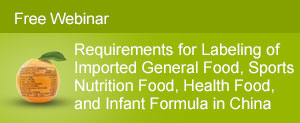The most important food safety standard for food contact additive in China isGB 9685-2008 Hygienic Standard for Use of Additives in Food Containers and Packaging Materials and it includes 959 permitted food contact additives (including monomers). The standard was issued by the Ministry of Health in Septemer 2008 and came into force on 1st June 2009.
What is New?
12 Nov 2013, A Preview of China's Plan to Revise Its Food Contact Standards. More info can be foundhere.
China GB 9685-2008 specifies the principles for uses of additives in food containers and packaging materials, the types of permitted additives, application scope, specific migration limit , maximum permitted quantity as well as other restrictive requirements.
One example is given as below:

GB 9685 defines food contact additives as the substances added to improve or assist to improve the quality and property of food containers and packaging materials to meet the expected purpose during the process of production; the assistants added in the process of producing food containers and packaging materials to help the smooth production but not to improve the quality and property of final products are also included. Since GB 9685 does not differentiate direct or indirect contact, many inks or adhesives to be used in food packaging materials and not intended to be indirect contact with food are also affected by this standard.
When the standard was issued in 2008, it received strong complaints from industry because many other food contact additives that had been approved in EU & USA or proved to be safe were already placed on Chinese market and were not yet included in the standard. To cope with this, the MoH and other ministries jointly issued a circular in 2009 allowing industry to petition by 1 June 2010 the Institute of Nutrition and Food Safety (INFS) for the listing of substances not yet listed on GB9685-2008 or other Chinese standards which are safe for contact use. This is called ‘Grandfathering Process’. As a result of this process, the MOH reviewed submitted petitions, approved more food contact additives in several batches and expanded the positive list from 959 substances to more than 1,500 food contact additives.
The update history of the positive list of food contact additives is listed as follows:
| Year of Issue | Regulation or Notice | No. of food contact additives approved |
| 2014 | MOH Notice 2014-126 | 4(Draft) |
| 2014 | MOH Notice 2013-8 | 4 |
| 2013 | MOH Notice 2013-168 | 1(Draft) |
| 2013 | MOH Notice 2013-5 | 258 |
| 2012 | MOH Notice 2012-11 | 3 |
| 2012 | MOH Notice 2012-5 | 301 |
| 2011 | MOH Notice 2011-10 | List of 107 Resins for FCMs |
| 2008 | GB 9685-2008 | 959 |
Many substances on Chinese positive list are from European positive list for contact additives and share the same SML or QM. However, there are several big differences between the positive lists in China and Europe.
| China | Europe |
|
|
Currently GB 9685 is being revised. The newly approved food contact additives will be added to GB 9685 to form a consolidated list. For those substances not on the positive list, the use in food containers and packaging materials is strictly forbidden unless food contact notification has been submitted and approved.
If you would like to get the English version of GB 9685-2008 and newly approved food contact additives, please complete this .
Food Contact Notification
New food contact additives that are not yet on the positive list must be approved by health authorties first. In 2011, the Ministry of Health (MOH) has published the Measures on Administrative Permission of New Varieties of Food Related Products and the measures have set detailed requirements on notification of new varieties of food related products (including new food packaging materials and new food contact additives). According to the measures, the following documents are required for food contact notifications.
- Application form and physio-chemical properties;
- Technical necessity, uses and conditions of use;
- Description of manufacturing process;
- Quality and safety control, analytical methods and test reports;
- Toxicology safety assessment data;
- Migration limit test, estimation and assessment of dietary exposure;
- Whether the additive has been approved or used in other countries;
- Other information which is helpful to review;
It shall be noted that the required toxicology safety assessment data depends on the overall migration limit (OML). If the OML is very low, lots of toxicology data can then be exempted.
Since the publication of the measures in 2011, 3 new food contact additives have been approved in the MOH’s notice 2012-11 in accordance with the measures.
Download
GB 9685-2008 Food Safety National Standards for Hygienic Standard for Use of Additives in Food Containers and Packaging Materials
Our Services
Initially set up by China Inspection and Quarantine(CIQ) Bureau in 2007 to provide REACH compliance services to Chinese chemical industry, CIRS has grown to be a leading provider of comprehensive chemical compliance services for companies doing businesses in/with China.
Our services for China include new substance notification, registration of the import and export of toxic chemicals, registration of hazardous chemicals, classification and labeling in according to China GHS, Chinese SDS, risk assessment of industrial chemicals, food additives, food contact materials and cosmetic ingredients. We provide one-stop solutions to your regulatory issues in China. We also deliver the most up-to-date regulatory information about chemical control laws in China. For food contact materials and food contact additives, we offer the following services:
Our services for China include new substance notification, registration of the import and export of toxic chemicals, registration of hazardous chemicals, classification and labeling in according to China GHS, Chinese SDS, risk assessment of industrial chemicals, food additives, food contact materials and cosmetic ingredients. We provide one-stop solutions to your regulatory issues in China. We also deliver the most up-to-date regulatory information about chemical control laws in China. For food contact materials and food contact additives, we offer the following services:
- Training on food contact legislation in China;
- Compliance advice to suppliers of food contact materials and food contact additives;
- Migration testing of finish articles according to China’s standards;
- Translated positive list of food contact additives;
- Food contact notification of new packaging materials or new food contact additives;
Contact Us
Ms. Cathy Yu, Senior Consultant, Food Safety Regulation, CIRS China
11F Dongguan Building, 288 Qiuyi Road, Binjiang District, Hangzhou, China, 310020
Tel : +86 571 8720 6538 | Fax : +86 571 8720 6533
Email: cathy.yu@hfoushi.com
11F Dongguan Building, 288 Qiuyi Road, Binjiang District, Hangzhou, China, 310020
Tel : +86 571 8720 6538 | Fax : +86 571 8720 6533
Email: cathy.yu@hfoushi.com






